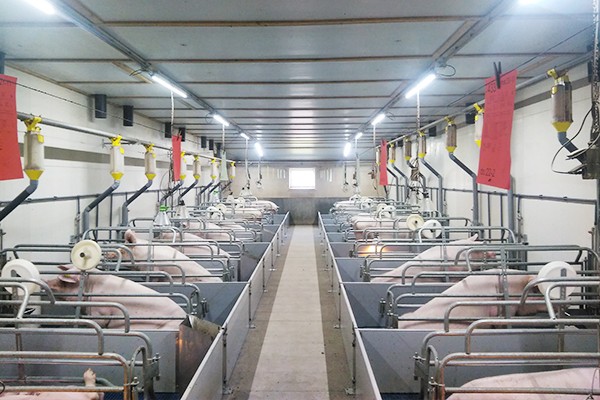Light plays a critical role in regulating the reproductive cycles of swine. It is the primary time giver that synchronizes pigs’ circadian rhythms and reproductive physiology to the day-night cycle. The color temperature of light is particularly significant because different wavelengths of light have distinct impacts. Red and blue light have been found to differentially affect swine reproduction through their influence on various hormonal, behavioral, and biological mechanisms. A red vs blue light comparison is crucial as it can help determine the right choice of products.
The Role of Red Light in Swine Reproduction
Red light has been found to play an essential but differing role in swine reproduction compared to other wavelengths. While it does not entirely suppress reproductive processes, research shows it elicits physiological and behavioral changes, unlike natural lighting conditions.
- Physiological Impact of Red Light
From a hormonal standpoint, when it comes to red vs blue light, exposure to red light is understood to inhibit melatonin secretion in pigs. This disruption of melatonin rhythms can impact the estrus cycle by suppressing essential reproductive hormones like follicle-stimulating hormone. The lack of triggering normal circadian signals under red light makes it less than ideal for inducing estrus.
- Behavioral Changes Under Red Light Exposure
At a behavioral level, pigs exposed predominantly to red light do not demonstrate typical mating behaviors. They remain fairly inactive and do not engage in vocalizations or physical interactions that are part of natural engagement and breeding patterns. This suggests red light may not provide the full stimulatory cues for inducing estrus expression.
- Comparison with Natural Light Cycles
Regarding daylight cycles of red vs blue light, red light does not as closely match the sun’s spectrum in the way it entrains pigs’ biorhythms. The circadian misalignment from red light alone can negatively influence the precision of estrus synchronization between sows. This implies natural light or hybrid light systems better regulate reproductive cycles.
The Influence of Blue Light on Swine Reproduction
Blue light has been found to play a supportive role in swine reproduction processes when used appropriately. In the red vs blue light comparison, several key biological responses differentiate blue light from red light in terms of triggering reproductive cues.
- Biological Reactions to Blue Light
At the hormonal level, blue light stimulates important increases in melatonin secretion for pigs. This helps set the body’s circadian rhythms and seasonal timed preparation for breeding cycles. The spectral properties of blue light also trigger retinal cells that regulate hormonal secretions.
- Comparative Analysis with Red Light
Unlike red light, blue light serves as a closer match to the sun’s spectrum pigs evolved under. It does a better job of training circadian rhythms compared to red light alone, making it superior in this aspect in the red vs. blue light comparison. The photoreceptor stimulation from blue light is more precisely implicated in synchronizing estrus onset.
- Impact on Stress and Welfare
While blue light exposure during nighttime resting can induce stress responses, tailored use of blue light also supports pigs’ natural behaviors and seasonal photoperiodic cues. This enhances welfare by reducing abnormal conditions like constant illumination. When it comes to red vs blue light, choosing blue light is important here as appropriate blue light regimes avoid stressful impacts on fattening and reproductive performance.
Product Highlight: IP67 Ammonia-Resistant T12 LED Swine Lighting
Hontech-Wins is a leading manufacturer of professional LED lighting solutions for agriculture. We have over a decade of experience in developing innovative farm lighting products. We offer various red vs blue light LED lighting fixtures and controls to meet different farm needs. We are committed to advancing animal welfare through reliable, expertly-engineered solutions.
220VAC IP67 Ammonia-Resistant T12 LED Swine Lighting is one of our top-selling products for pig farms. This linear-shaped fixture provides dependable lighting optimized for pig barns. Key characteristics that make this piglet light a preferred choice for this include:
- Durability
The fixture has an IP67 and IP69K waterproof and dustproof rating. This means it has a strong resistance to harsh agricultural environments. The fixture also features a corrosion-resistant construction that can withstand exposure to ammonia and other chemicals during cleaning.
- Energy Efficiency
The light has a long lifespan of over 50,000 hours using high-quality, low-power LED components. It is equipped with premium LEDs that maintain optimal light output and efficiency for years of use.
- Spectrum Variability
The fixture can generate variable color temperatures between warm 2700K and daylight 4000K spectrum. Spectrum dimming allows for the simulation of natural sunrise/sunset lighting cycles. Precise spectrum tuning optimizes pig biological rhythms and reproductive processes.
Conclusion
Overall, the comparison of red vs. blue light is important because the differential light of these colors affects swine reproduction cycles through impacts on hormonal, behavioral, and circadian mechanisms. Red light suppresses estrus expression, while blue light promotes it. Proper blue light exposure during nighttime resting periods also enhances pig welfare. For reliable LED lighting designed specifically for pig production needs, we at Hontech-Wins offer innovative, high-performance fixtures. Please contact Hontech-Wins to learn our full lineup of livestock lighting products and solutions.


